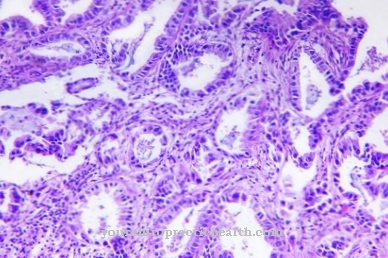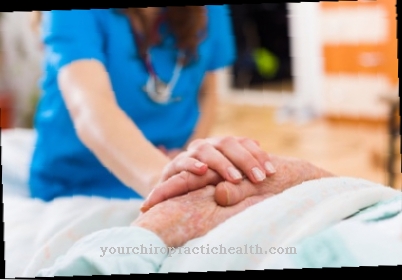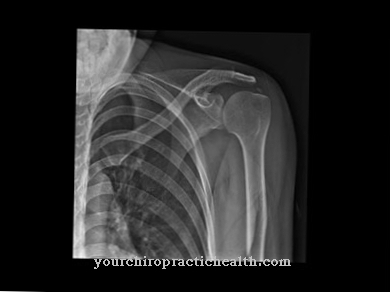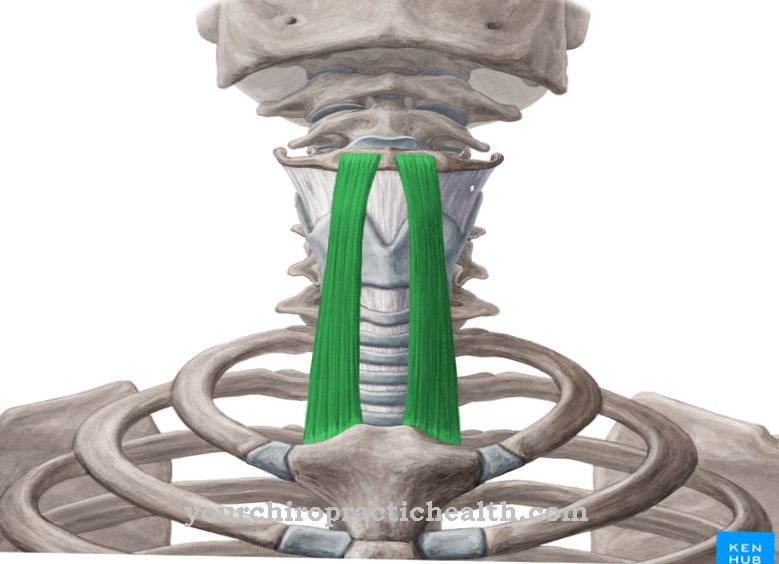A HIV infection is not the same as AIDS. An infection by the HI virus (HIV) is initially only infection by the triggering virus, which can subsequently lead to AIDS.
What is HIV Infection?

The human immunodeficiency virus is known in English as human deficiency virus, or HIV for short. When infected with such viruses, one does not immediately speak of an AIDS disease, because AIDS only describes the appearance of the first symptoms and not the infection with this pathogen itself.
Recognizable symptoms due to an infection describe the end stage of HIV, one speaks now of a disease, the acquired immune deficiency syndrome - AIDS. HIV infection was first described in the USA in the 1980s and is still a treatable but incurable and mostly fatal disease to this day.
causes
The most common way of transmission of an HIV infection is unprotected sexual intercourse. The partners become infected unnoticed through the smallest injuries to the mucous membrane. The risk of HIV infection is also very high when HIV-infected blood is transmitted; this often happens in the drug environment when addicts use syringes and needles from other addicts. A very small proportion of those infected became infected during pregnancy or through breastfeeding to a sick mother.
In general, a certain amount of virus material is necessary for transmission and this takes place via body fluids such as blood, semen, vaginal secretions and breast milk. A droplet infection is not possible. Inadequate education of the population about this disease and poor knowledge of the risk of infection prevent this infectious disease from being contained. Its prevalence is particularly high in South Africa.
Symptoms, ailments & signs
An HIV infection often shows symptoms in the acute phase after infection. These then occur within a few days or weeks. They include rash on the upper body, heavy night sweats, mouth sores, fever, fatigue, and headache and neck pain. Joint pain, swollen lymph nodes, and swollen tonsils are also common. Overall, the symptoms can be very similar to those of the flu.
Occasionally it happens that infected people show no symptoms at all. Also, almost never all symptoms occur at the same time, only some or only one of them. Because most of the symptoms are rather unspecific, no HIV infection can be inferred from this.
Once the acute phase of HIV infection is over and the body has produced antibodies, the symptoms subside. There is a long and symptom-free latency phase. Finally, when the immune system is sufficiently damaged by HIV, opportunistic infections can occur, the type and amount of which determine whether AIDS is ultimately diagnosed. The transition from HIV infection with serious symptoms to AIDS is fluid in this case. The opportunistic infections include fungal infections, bacterial and viral infections, and various other conditions that can occur in immunocompromised people.
course
HIV is one of the retroviruses and it needs the nucleus of a host cell to multiply. Within the course of the disease one HIV infection different stages of the disease can be distinguished. After the infection, symptoms often appear a few weeks later that are very similar to flu and can therefore go unnoticed: fever, diarrhea, headache, swelling of the lymph nodes, pain in the limbs.
In the following years, HIV antibodies are detectable in the patient, but the infected can live without symptoms. In the so-called lymphadenopathy syndrome, lymph node swellings can occur over several months in various parts of the body, and in the AIDS-related complex, weight loss, night sweats and fever can be seen. The average life expectancy at the outbreak of full AIDS is only two years; opportunistic infections occur and malignant tumors can develop.
Complications
There are many complications associated with HIV infection. On the one hand, the thought of suffering from an HIV infection is a heavy burden for the person affected, as this is not curable according to the current medical status. This can develop into depression. This, in turn, can cause a weakened self-esteem and be associated with sleep disorders, fatigue and a decline in performance.
In some cases, addictive behavior to alcohol and drugs is intensified, which can have serious consequences. In the worst cases, those affected can have a thought of suicide, which they then carry out. Furthermore, if left untreated, HIV infection can spread and end-stage AIDS can develop.
Those affected are very susceptible to infections and other diseases, so that they get sick more quickly. Even more unusual diseases such as a fungal disease (for example Candidasoor) or atypical pneumonia are now occurring more frequently. Harmless infections, which normally heal spontaneously in healthy people, are life-threatening for AIDS patients.
Rare tumor diseases such as Kaposi's sarcoma can occur especially in people with AIDS. Life expectancy is also lower. AIDS sufferers have a further life expectancy of ten years with therapy, and only one year without therapy. There is also the risk that people infected with HIV can infect other people if they engage in unprotected sexual intercourse.
When should you go to the doctor?
Since an HIV infection can in the worst case lead to the death of the person affected, this disease must always be examined by a doctor. Although direct treatment is not possible, visits and regular examinations with a doctor are very useful. As a rule, persistent tiredness and fatigue can indicate an HIV infection. Severe headaches or aching limbs also occur and are accompanied by diarrhea or vomiting.
Many patients also suffer from a fever or loss of appetite due to the HIV infection. If these symptoms occur over a longer period of time, a visit to a doctor is necessary. Furthermore, many sufferers also suffer from severe itching or a rash on the skin. The susceptibility to infections also increases significantly due to the HIV infection, so that those affected suffer more frequently from inflammation and infections.
Limitations and problems with the nerves can also point to the HIV infection. If there is any suspicion, the HIV infection can be examined by a general practitioner. Further treatment of the disease depends on the symptoms.
Doctors & therapists in your area
Treatment & Therapy
In principle, the disease with AIDS cannot yet be cured; the course of the HIV infection can at best be delayed. An effective therapy method is highly active antiretroviral therapy, or HAART for short. Here, at least three different antiretroviral drugs are combined with one another, which are supposed to inhibit HIV replication, whereby the immune system can be strengthened and symptoms regressed.
This therapy requires good cooperation from the patient. However, taking these inhibitory drugs leads to enormous side effects. Serious damage to the intestines, liver, nerves or the cardiovascular system is possible with lifelong treatment.
This combination therapy sometimes has to be changed or even canceled due to the undesirable effects that occur. It is important that the drugs used in combination therapy for the treatment of HIV infection do not lead to resistance and thus no longer have an inhibitory effect.
AIDS is a multi-system disease, which means that in addition to medical treatment and counseling, psychosocial care is also very important. The social system of a patient is influenced, necessary changes in professional respects can arise and social withdrawal is often the result of persistent depression, fears or feelings of guilt in an infected person.
Outlook & forecast
The prognosis for HIV infection depends on when drug treatment is started after the infection. The occurrence of other chronic diseases also plays a role in the prognosis.
If left untreated, it can be expected after an HIV infection that within 8 to 15 years the immune system of the affected person will be destroyed to such an extent that AIDS will break out and death will occur due to the diseases that occur. This prognosis can be very different from individual case to individual case. In a few cases, the virus remains inactive for life and those affected have a barely suppressed immune system.
However, the prognosis with consistent antiretroviral treatment is significantly better. In the vast majority of cases, the outbreak of AIDS can be prevented thanks to combination drug therapy. The life expectancy of people who are 25 years old or younger at the time of starting therapy and who do not suffer from any other illnesses is not considered to be reduced.
The situation is different in cases in which other diseases, such as hepatitis C or an addictive disease, limit the lives of those affected. Life expectancies can be shortened here by several years.
In addition, the drugs can lead to long-term damage to the kidneys, for example, or to the distribution of fat. However, these consequences can be easily controlled by changing the medication in good time. Overall, however, the prognosis for an HIV infection is good and, due to new drugs, it is to be expected that the side effects will be less severe.
Aftercare
According to the current state of science, HIV is not curable. Those affected therefore have to deal with the consequences for a lifetime. Follow-up care aims to prevent the transition to AIDS and alleviate any symptoms. In addition to personal responsibility, which is maintained through protected sexual intercourse, among other things, medical support is necessary.
Since a combination of agents is present, regular follow-up examinations are indicated. The current status is determined primarily through blood tests. Changes in medication are not uncommon. It is not uncommon for patients to report side effects. The active ingredients inhibit the docking of the virus with the immune cells, block certain virus enzymes or interfere with another enzyme.
Entry inhibitors, integrase inhibitors, protease inhibitors and reverse transcriptase inhibitors are suitable. It appears problematic that the HI virus mutates after a while. This requires close inspection. Patients should strictly adhere to the doctor's suggested rhythm.
If acute symptoms occur, a general practitioner should be consulted immediately in view of the permanent weakening of the body. In the social area, the closest people should be informed about the disease. Agreements for the outbreak of AIDS are important. Sometimes HIV infection also leads to existential fears. If necessary, psychological or pastoral support is necessary.
You can do that yourself
The infection with HIV usually represents a psychological burden for those affected, which can be felt especially immediately after a diagnosis. The possibilities for those affected to live better with their illness - i.e. the actual infection - in everyday life are, however, superfluous thanks to drug therapy. With a good drug attitude, HIV-positive people do not have to follow a drastic lifestyle.
Rather, the self-help measures deal with learning everything worth knowing about the disease, understanding the therapy and its effects and thus regaining the feeling of control. After all, being infected with HIV is no longer a death sentence. Self-help groups, AIDS support groups and similar organizations are available in many cities to obtain information and exchange information.
Those affected often have to rebuild their good attitude towards life. The environment must also be included, with HIV-positive people having to decide for themselves who will find out about the infection and who will not. It cannot be ruled out that this can trigger unpleasant situations in everyday life that arise from ignorance or prejudice of others. Providing education and dealing with the situation with confidence can help.
In order to generally strengthen the immune system, you should still eat a healthy and balanced diet - especially if minor illnesses occur frequently. Exercise also strengthens and can be positive for the psyche at the same time.



.jpg)




.jpg)





.jpg)






.jpg)






